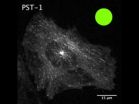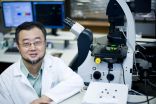(Press-News.org) A new technique that uses light to activate chemotherapy drugs in specific cells shows promise as a way to improve the effectiveness of cancer therapies while preventing severe side effects, according to a study published July 9 in Cell. The so-called photopharmacology approach could be used to treat a broad range of tumors with unprecedented precision simply by making existing cancer drugs sensitive to light--an approach that requires less time and effort compared with traditional drug discovery programs.
"We hope that our compounds will one day be used in medicine to deliver a killer blow to many types of localized cancer tumors, without producing side effects, thus improving on standards of care and also providing chemotherapy options for currently untreatable tumors," says co-senior author Oliver Thorn-Seshold of Ludwig-Maximilians-Universität München.
Some of the most successful and widely used chemotherapeutic drugs are inhibitors that interfere with the function of microtubules--components of the cell's skeleton that play a key role in cell proliferation, migration, and survival. But because these drugs do not specifically target cancer cells, they also interfere with the function of normal cells and cause severe side effects, such as heart and nerve damage. As a result, microtubule inhibitors are often limited to relatively low doses that do not provide the best therapeutic benefit.
To overcome this challenge, Thorn-Seshold and his collaborators developed a method for optically controlling microtubule inhibitor drugs currently in clinical trials, with high spatial precision. The strategy involves identifying a fixed structural element that is required for a drug's biological activity, then replacing that element with a flexible hinge that swings open or shut in response to blue light.
"We can then use light to switch the hinged drug on and off, where and when we want, with single-cell precision" says co-senior author Dirk Trauner, also of Ludwig-Maximilians-Universität München. "The upshot is that our compounds retain the powerful anticancer effects of existing microtubule inhibitors, but add the bonus of tissue-specific localization."
The researchers demonstrated that these modified compounds, called photostatins, are effective at inhibiting the proliferation and survival of cells targeted by light, while neighboring cells are unaffected. They can be switched on and off hundreds of times, making them suitable for long-term applications in both the clinic and the lab. Moreover, because they target a critical microtubule subunit that is found in the cells of all plants and animals, they can be used to study or treat a broad range of organisms or processes, even potentially a broad range of diseases in humans.
"We imagine that, since they eliminate systemic side effects, our compounds will be able to be used in medicine at dosages that are truly therapeutic in tumors, thus achieving a much more effective therapy than currently possible," Thorn-Seshold says. "On the research front, we hope that they will allow researchers worldwide to unravel the fine details underlying many important biophysical processes in cells, such as how mitosis is driven, how cells move or invade, and how the genetically determined sequence of embryogenesis is important for correct development."
In future clinical settings, the study authors imagine that patients could wear blue-tinted glasses to treat eye cancer or other eye diseases, while individuals with skin cancer could wear a bandage that delivers light to tumors. On the other hand, internal tumors might be treated with an implantable network of tiny LEDs that blink every few minutes to maintain the chemotherapeutic effect only in the enclosed tumor site.
In the meantime, the researchers are trying to stretch the limits of their technique with more precise and effective compounds, while refining the technique to treat tumors in mice. "The field of photopharmacology is very young, so it may take some time for the pharmaceutical industry to recognize the value of these compounds," Thorn-Seshold says. "Yet, if our ongoing studies are successful, we will have a convincing proposition for further preclinical development, and we are committed to getting as far into real therapy as we can."
INFORMATION:
Cell, Borowiak et al.: "Photoswitchable Inhibitors of Microtubule Dynamics Optically Control Mitosis and Cell Death" http://dx.doi.org/10.1016/j.cell.2015.06.049
Cell, the flagship journal of Cell Press, is a bimonthly journal that publishes findings of unusual significance in any area of experimental biology, including but not limited to cell biology, molecular biology, neuroscience, immunology, virology and microbiology, cancer, human genetics, systems biology, signaling, and disease mechanisms and therapeutics. For more information, please visit http://www.cell.com/cell. To receive media alerts for Cell or other Cell Press journals, contact press@cell.com.
CAMBRIDGE, MA -- The "friendly" bacteria inside our digestive systems are being given an upgrade, which may one day allow them to be programmed to detect and ultimately treat diseases such as colon cancer and immune disorders.
In a paper published today in the journal Cell Systems, researchers at MIT unveil a series of sensors, memory switches, and circuits that can be encoded in the common human gut bacterium Bacteroides thetaiotaomicron.
These basic computing elements will allow the bacteria to sense, memorize, and respond to signals in the gut, with future applications ...
While human activities have caused extinctions across the globe, your favourite beach or diving site may actually be home to as many, or more, species then it was a few decades ago.
That's the conclusion of a synthesis of 50 years of marine biodiversity data conducted by University of British Columbia (UBC) researchers.
But there is a catch. Like other studies of its kind, the synthesis relies on species population time series from sites that haven't been subject to intense human development.
"Much as you'd expect, our study shows human impacts like pollution and ...
A study to examine recessively inherited genome-wide DNA sequences has for the first time discovered a potential link with Britain's biggest killer - Coronary Artery Disease (CAD).
The research led by a team from the University of Leicester was the first time that recessively inherited DNA sequences in the whole genome called Runs of homozygosity (ROHs) were examined for a connection to the disease.
The study appears in the American Journal of Human Genetics.
CAD is a terminal clinical manifestation of cardiovascular disease and is the leading cause of death worldwide ...
Danish researchers are the first in the world to have used our genes to investigate the impact of coffee on the body. The new study shows that coffee neither increases nor decreases the risk of lifestyle diseases.
We love coffee - and we drink a lot of it. New research from the University of Copenhagen and Herlev and Gentofte Hospital shows that coffee neither increases nor decreases the risk of developing lifestyle diseases such as obesity and diabetes. The researchers have based their study on genes, as our genes play a role in how much coffee we drink in the course ...
DENVER (July 9, 2015) - A new study from the University of Colorado Denver finds that male exotic dancers, or strippers, remain committed to stripping because it enhances their self-concept.
The study by Maren Scull, an instructor of Sociology in the CU Denver College of Liberal Arts and Sciences, was published online this month in Deviant Behavior, the only scientific journal that specifically addresses behaviors that violate social norms. Scull's research focuses on how exotic dancing influences the way male strippers view themselves.
"Because stripping is a stigmatizing ...
This news release is available in French.
Since the treatment has become available, HIV is often described as "undetectable" and the risk of transmission has been drastically reduced. However, the epidemic is still quite present in the lives of many gay and bisexual men... and in public spaces. This often overlooked dimension of the disease has been brought to light by Gabriel Girard of the University of Montreal's Public Health Research Institute (IRSPUM) - HIV is still alive in the city, especially in the Village, Montreal's gay district. "Urban traces are significant ...
WEST LAFAYETTE, Ind. -- A key set of immune cells that protect the body from infection would be lost without directions provided by vitamin A, according to a recent study.
A team of researchers from Purdue University found retinoic acid, a metabolite that comes from digested vitamin A, is necessary for two of the three types of innate immune cells that reside in the intestine to find their proper place.
"It is known that vitamin A deficiencies lead to increased susceptibility to disease and low concentrations of immune cells in the mucosal barrier that lines the intestines," ...
MADISON, Wis. -- A study authored by two University of Wisconsin-Madison graduate students indicates that while playing video games can improve mood, violent games may increase aggressive outcomes.
The study, authored by James Alex Bonus and Alanna Peebles, graduate students in Communication Arts, and Karyn Riddle, assistant professor in the School of Journalism and Mass Communication, was published in June in the journal Computers in Human Behavior. The researchers looked at how video games may be used to manage emotions -- specifically, whether playing the games can ...
(Edmonton) Screening newborn babies who are in the neonatal intensive care unit (NICU) using a testing process called high-frequency tympanometry can help identify middle-ear problems earlier, according to newly published research from a local team of researchers.
"If people cannot hear, we need to know if the problem is with the middle ear, inner ear or hearing nerve. Obviously, a baby cannot tell you, so in the clinic it's hard to know when they have hearing loss," explained Ming Zhang, an associate professor at the U of A's Department of Communication Sciences and ...
The relationship between mental and physical health is well established. But when mental and physical illnesses co-occur, patients' accounts of physical illness are sometimes arbitrarily discredited or dismissed by physicians.
Research by Jeremy D. Coplan, MD, professor of psychiatry at SUNY Downstate Medical Center, and colleagues has documented a high rate of association between panic disorder and four domains of physical illness. The research could alter how physicians and psychiatrists view the boundaries within and between psychiatric and medical disorders.
"Patients ...





